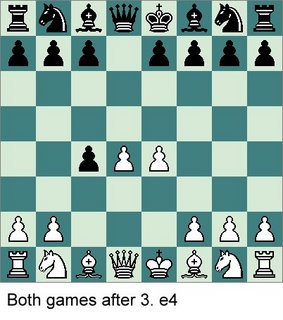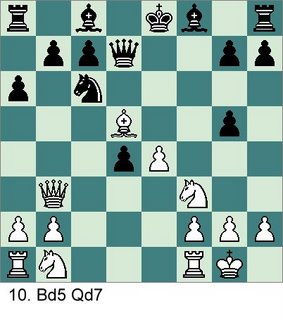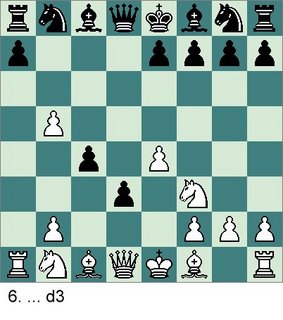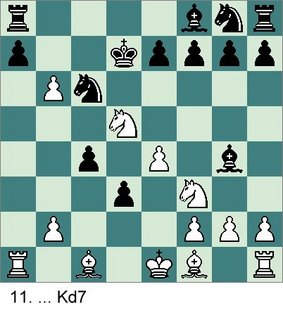Game 1:
1.d4 d5
2.c4 dxc4
3.e4
 3. ... e5
3. ... e5He would like me to take his pawn, which would allow him to exchange Queens and remove my castling capabilities.
4.Nf3 exd4
5.Bxc4 a6
6.Qb3
Not exactly the line I know, but it creates a nice attack on his King side.
6. ... Qe7
7.0-0 Nc6
8.Bg5

That's it with the QGA, white gets very fast development and black can become very constricted. Note black can not take e4, since Rook to e1 pins the Queen to her King.
8. ... f6
9.Bxg8 fxg5
I decide to exchange my bishop for his knight, wrecking his king side pawn structure. Its always nice when your opponent helps you with your plans.
 10.Bd5 Qd7
10.Bd5 Qd7I threaten to exchange my Bishop or his knight, messing up his queen side pawns. He defends the knight with his Queen, leaving his g5 pawn undefended. After my knight takes his g5 pawn, there is a very nice 3 piece attack on his f7 square.
11.Nxg5 Na5
12.Bf7+ Ke7
13.Qb4+
Wins the knight because his King must retreat.
13. ... Kd8
14.Qxa5 h6
15.Be6 Qe7
Black realizes his position is hopeless and resigns.
Game 2
1.d4 d5
2.c4 dxc4
3.e4 c5
My opponent plays the c pawn up instead of the e pawn. Same idea though, if I take he exchanges queens and removes my castling capabilities.
4.Nf3 b5
5.a4 cxd4
 6.axb5 d3
6.axb5 d3As in the image above, it looks like my position is very constricted. But I don't believe he can hold onto his central pawns. They are over extended and therefore my strategy is to colapse his center.
7.Qa4 Qc7!

A good move, which allows him to hold onto those central pawns (at least temporarily.)
8.b6+ Qc6
9.Qxc6+
I didn't want to exchange queens, but it looked like my best alternative. It leaves my nasty pawn on b6 and he can't take it with his pawn, because my rook would then capture his.
9. ... Nxc6
10.Nc3 Bg4
 11.Nd5
11.Nd5Threatening Nc7+, forking the King and Rook.
11. ... Kd7

At this point I came up with a plan. Move the Knight e5 and allow his knight to capture (as if he has any choice since its check,) then Rook takes a7+ and after his rook recaptures the pawn goes in unhindered. And thats how it worked! I love it when a plan comes together.
12.Ne5+! Nxe5
13.Rxa7+ Rxa7
14.bxa7 e6!
Another cute move, trying to get as much of my material as possible. But after looking it over, I decided to let him take it. Since my queen will take back and be on a good central square and recapture his knight (or Bishop depending on how he plays it.)
 15.a8Q Bc5
15.a8Q Bc516.Ne3 Bxe3
17.Bxe3 Ne7
I probably should have taken the Rook and been done with it. But I wanted to attack the King, not go on a piece eating lark and the game was in the center.
18.Qa7+ Kc6
19.Qc5+ Kd7
20.Qxe5 Ra8
21.Qb5+ Kd8
22.Bb6+ Kc8
23.Qxc4+ Kd7
Black Resigns!!!
What should be learned from these games.
1. I personally don't recomend playing the QGA as black, but our local master says it is very sound. As black only play the Queens Gambit Accepted with caution (and book knowlege.) White in my opinion has a decided advantage and for black to win against a prepared player takes some depth of knowlege. To know how to play this with white, I recomend reading "Attacking with 1.d4, by Dunnington." Both of my opponents here were moderately strong, the first had a 1448 FICS rating and second had a 1417, while mine was 1379 (it goes up and down.) I think they pick up a lot of games from players who don't know how to defend in the QGA.
The game of the week was number 2, he was a little more booked up and therefore was more challenging. And its always more fun when you can force a pawn promotion!
Terry
No comments:
Post a Comment